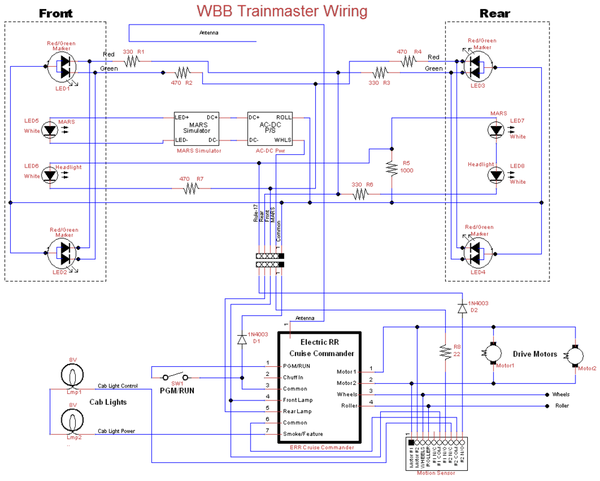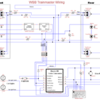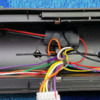I've recently been working on detailing a set of older MTH F3s. These units were upgraded to TMCC from PS1. I wast to switch out the original green front marker lights with red ones, I just need to know what type of LED they are and where I can buy some. Thanks for any help.
Replies sorted oldest to newest
Class lights would only be red to mark the rear end of the engine consist. Why do want them to be red? I would just unplug them all together.
Here's some information I found, from a couple of commentators. It's a little complicated, but interesting. There also was some variation among different roads, according to their individual practices. (There's information on practices of different railroads in other commentary for those interested. The OP might want to check out Pennsy's practices.) One thing's for sure - red lights were never used as classification lights (which are the lights on the front of the engine). The OP should chose white or green, or else leave them turned off.
"Classification lights (or flags) were on the front, leading end of an engine.
Markers are on the rear of the train.
Two different animals, two different sets of rules.
A single section isn't a section, its "the" train. A section is when you run two or more trains on the same schedule. While the sections have to be reasonably close together or it delays other trains, unless prohibited by the rules, sections do not have to immediately follow each other.
A regular train, one with a timetable schedule displays NO class lights.
If there are sections of the schedule, all sections except the last one display green class lights on the leading engine.
If the train is running or works extra, it displays white class lights.
ALL trains, every section, first section, last section, every regular train, every extra train displays a marker on the rear car.
There is no such thing as a red class light. A marker is a red light or flag by day and red light by night.
What tells a train the last section has gone by is that a train goes by with no class lights.
Class lights are ONLY displayed on the engine. Marker lights are ONLY displayed on the rear of the train. Marker lights often had other color patterns than red, but they indicated things like whether the train was in the clear or which track the train was running on, they had NOTHING to do with sections, extras or the class of a train.
Timetables and TRAIN ORDERS go together. Schedules (sections, extras, etc) and track warrants are mutually exclusive. Track warrants (west of the Mississippi) ended scheduled trains, sections and extras.
You can't be an extra OR a lower class of train. Extras do NOT have the attribute of "class", they are not a lesser class. Only regular trains have class.
Virtually no trains west of the Mississippi are identified for track authority as "extras", definitely not on any of the class 1 railroads. When the GCOR was adopted in 1985, the idea of an extra train and the class of trains went away. West of the Mississippi, virtually all of the manifest, intermodal and auto trains operate on a service schedule, but the schedule does not grant main track authority. Only the bulk trains (coal , grain, ore, rock, etc.) operate on an unscheduled basis. Railroads operate "regular trains", "extras" and "sections" but all that means is whether they have a service schedule or were an ad hoc train to carry excess business or the plan was to run more trains of one schedule in a day."
________________________________________________________________________________
"Classification lights, back in the days when they were used, came in two varieties: green to indicate that another section of the same train was following (the last section would not carry class lights or flags) and white to denote an extra train.
The marker lights on a caboose were not classification lights, but basically defined a train--"Displaying markers" was, and still is, an essential part of the definition of a "train". The markers on a caboose were red to the rear and green in all other directions while the train was on the main track; when the train took siding the markers were adjusted to show green to the rear, indicating that the train was in the clear.
The red lights that could be shown on a locomotive in the places where classification lights are normally displayed are also markers--displayed to the rear in a light-engine movement (or, in the case of Metra, when the locomotive is pushing a scoot),
The use of classification lights basically went out with timetable/train-order operation methods, so to find rules pertaining t them you'd have to go back to the days of the Consolidated Code of Operating Rules (for western railroads) or individual railroads' rulebooks (for eastern railroads). In the Consolidated Code, classification lights were covered under Rules 20, 21, and 23."
The LED's used are Lumex 2mm ceramic LED's. They come in Red, Yellow, and Green.
I had done a project, several years ago, with a set of Weaver E8's that were upgrade to TMCC. Not prototypical, but if you are not using the smoke unit, the markers can be upgrade with bi-polar/color LED's The LED colors would reverse with the engine directions. Material and instructions were provide as a kit from TAS Train America Studio.

You don't need the smoke output to drive those lights in case you want to control cab lights with it. Here's the wiring of a Train Master where I added directional markers as well as a MARS light, etc.
Attachments
I think what I'll do is put the unit with the green lights back in the front, and disconnect the wires to them. Maybe I'll even paint the LEDs a dull grey/khaki color to look like dirty glass. Rear unit I'll leave alone to get red lights at the rear of the consist. Thanks for the help everyone.
I believe the PRR stopped using classification lights some time in the 1930s, I'm not sure of the exact year. But the Pennsy did use marker lights on the front of its locomotives for reverse movements. So red LEDs are appropriate for your project, but they should only be illuminated for reverse movements when the locomotive is the end of the train
Of course your running on three rails so whatever suits you is the right answer! I especially liked the bipolar LED idea














